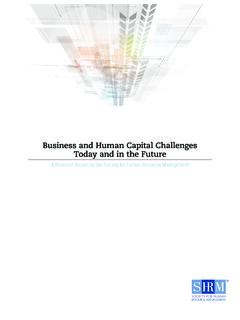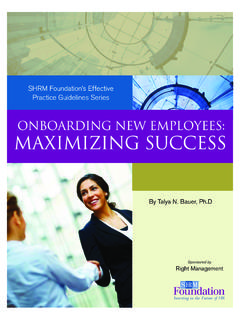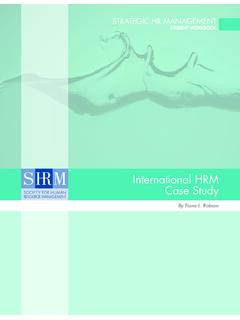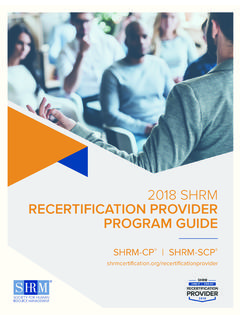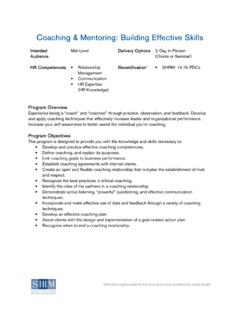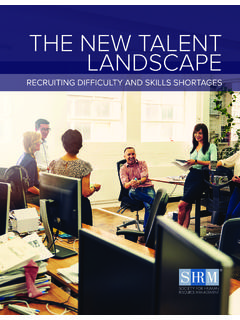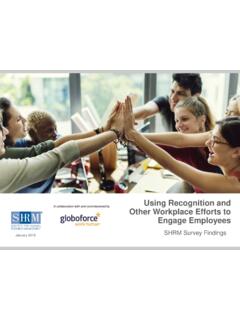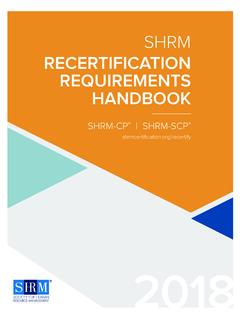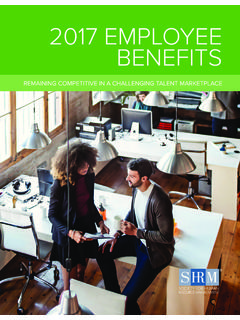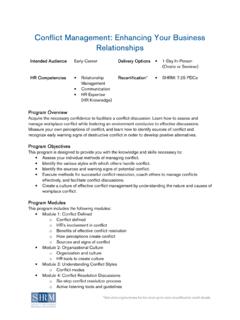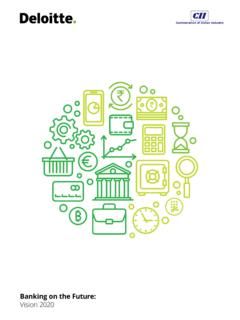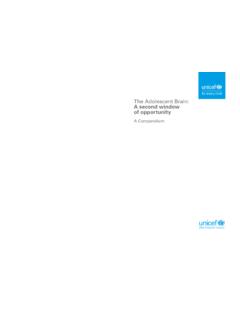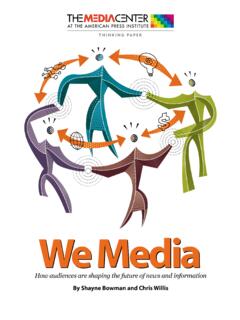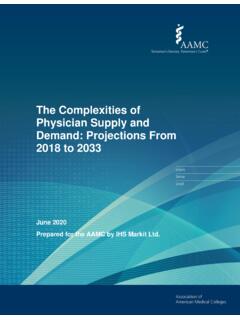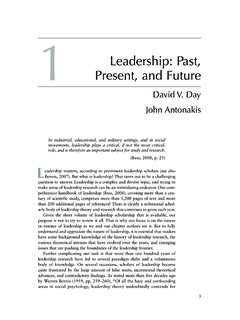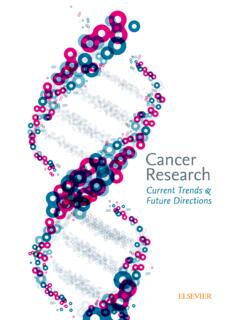Transcription of SHRM Foundation’s Effective Practice Guidelines Series
1 By Richard D. Johnson and Hal G. GueutalSHRM Foundation s Effective Practice Guidelines SeriesSponsored by ADPThe Use of E-HR and HRIS in OrganizationsTransforming HR Through Technology This publication is designed to provide accurate and authoritative information regarding the subject matter covered. Neither the publisher nor the author is engaged in rendering legal or other professional service. If legal advice or other expert assistance is required, the services of a competent, licensed professional should be sought. Any federal and state laws discussed in this book are subject to frequent revision and inter-pretation by amendments or judicial revisions that may significantly affect employer or employee rights and obligations. Readers are encour-aged to seek legal counsel regarding specific policies and practices in their book is published by the SHRM Foundation, an affiliate of the Society for Human Resource Management (SHRM ).
2 The interpretations, conclusions and recommendations in this book are those of the author and do not necessarily represent those of the SHRM Foundation. 2011 SHRM Foundation. All rights reserved. Printed in the United States of publication may not be reproduced, stored in a retrieval system or transmitted in whole or in part, in any form or by any means, electronic, mechanical, photocopying, recording or otherwise, without the prior written permission of the SHRM Foundation, 1800 Duke Street, Alexandria, VA SHRM Foundation is the 501(c)3 nonprofit affiliate of the Society for Human Resource Management (SHRM). The SHRM Foundation maximizes the impact of the HR profession on organizational decision-making and performance by promoting innovation, education, research and the use of research-based knowledge.
3 The Foundation is governed by a volunteer board of directors, comprising distinguished HR aca-demic and Practice leaders. Contributions to the SHRM Foundation are tax deductible. For more information, contact the SHRM Foundation at (703) 535-6020. Online at Use of E-HR and HRIS in OrganizationsTransforming HR Through Technology11-0083 ContentsTable of v Forewordvii Acknowledgmentsix About the Authors 1 Transforming HR Through Technology: The Use of E-HR and HRIS in Organizations 2 Implementation of HRIS: What Are the Options? 4 Access to HR Data 8 Using HR Technology 25 The future : Five-Year Trends in HR Technology 27 Conclusion29 Sources and Suggested Readings iiiDear Colleague:Human resource management is evolving into a more technology-based profession.
4 In many organizations, employees now see the face of HR as a portal rather than a person. This transformation of HR service delivery is known as e-HR, and implementing e-HR requires a fundamental change in the way HR professionals view their new report, Transforming HR Through Technology: The Use of E-HR and HRIS in Organizations, will help you to explore both the opportunities and the potential pitfalls of HR technology. According to recent studies, organizations that successfully adopt sophisticated HR technology tools outperform those that do not. This report will help you to better leverage e-HR to transform your HR practices and market your HR 2004, the SHRM Foundation created this Effective Practice Guidelines Series for busy HR professionals like you. We understand that it s a challenge for practitioners with limited time to keep up with the latest research results.
5 By integrating research findings on what works with expert opinion on how to conduct Effective HR Practice , we make theory and Practice more accessible to reports in this Series include Onboarding New Employees, The Search for Executive Talent, Employment Downsizing and Its Alternatives, and Human Resource Strategy. This report is the 13th in the Series . Subject matter experts write the reports, which are then reviewed by both academics and practitioners to ensure that the material is research-based, comprehensive and practical. Each report also includes a Suggested Readings section as a convenient reference tool. All reports are available online for free download at Effective Practice Guidelines Series is just one way the SHRM Foundation supports lifelong learning for HR professionals. In addition to creating educational resources, the SHRM Foundation awards more than $150,000 annually in education and certification scholarships, and is a major funder of original, rigorous HR research that expands the HR knowledge base.
6 I encourage you to learn more. Please visit to find out how you can get involved with the SHRM A. Gowan, Chair, SHRM Foundation Research Evidence Committee Dean and Professor of Management Martha and Spencer Love School of Business Elon UniversityForewordvAcknowledgmentsThe SHRM Foundation is grateful for the assistance of the following individuals in producing this report: Major funding for the Effective Practice Guidelines Series is provided by the HR Certification Institute and the Society for Human Resource Management. Content editorLynn McFarland, Human Capital Solutions, J. Hoover, SPHR Human Resources Arysta LifeScience North America, LLCA aron D. Lambert, PHR ConsultantDamon Lovett, HRIP Director, Professional Services AquireKristin Lundin, SPHR Product Manager ann Mosa, MBA Human Capital Consultant Resources Global ProfessionalsElaine Orler President Talent Function Group LLCD iane Pattin Master Data Team Leader / Human Resources BDJohn Ryder, SPHR Vice President Human Resources Champion TechnologiesDebra Sieloff, MSE Development Enablement Program Manager SAP, Wise, SPHR President Wise Consulting Associates, ManagerBeth M.
7 McFarland, CAE Manager, Special Projects SHRM FoundationviiAbout the AuthorSRICHARD D. JOHNSON Richard D. Johnson is an assistant professor in the School of Business at the University at Albany. He teaches courses in human resource information systems and his research interests include e-HR, e-learning, psychological and sociological impacts of technology, psychology and computer use, motivation, and the digital divide. He also is co-author of the forthcoming book, Human Resource Information Systems: Basics, Applications, and future directions . Hal G. GueutalHal G. Gueutal is a co-author of The Brave New World of eHR: Human Resources in the Digital Age. An associate professor of management at the University at Albany, he serves as director of the MBA concentration in e-HR. He has consulted with a wide range of organizations on HR technology issues as well as business and HR strategy, and his research focuses on e-HR trends and success term e-HR describes the transformation of HR service delivery using web-based technology.
8 Now HR professionals must not only master traditional HR skills and knowledge, but also have the ability to apply that knowledge via HR Through TechnologyTransforming HR Through TechnologyThe Use of E-HR and HRIS in OrganizationsToday the face of HR is often a portal, rather than a person. Almost all firms now provide universal access to HR services through technology and web-based applications, dramatically changing the Practice of human resource management. These changes often result from the need to cut costs and expand or improve services. Recent research shows organizations that successfully adopt sophisticated HR technology tools outperform those that do But because most organizations already have automated basic HR administration, the simple automation of HR processes can no longer assure a competitive advantage.
9 Instead, organizations must determine how to use technology to transform their HR practices and market their HR brand. HR is evolving into a more technology-based profession because organizations need to: Streamline HR processes and reduce administrative burdens. Reduce HR administration and compliance costs. Compete more effectively for global talent. Improve service and access to data for employees and managers. Provide real-time metrics to allow decision-makers to spot trends and manage the workforce more effectively. Enable HR to transform so it can play a more strategic role in the term e-HR describes the transformation of HR service delivery using web-based technology. Implementing e-HR requires a fundamental change in the way HR professionals view their roles. Now HR professionals must not only master traditional HR skills and knowledge, but also have the ability to apply that knowledge via report focuses on human resource information systems (HRIS), or the integration of hardware, software and business processes used to implement an e-HR HR departments often provide broader and more Effective services when they operate via a web portal.
10 For employees and 2 Transforming HR Through Technologyapplicants, this means relying on HRIS for most HR services. One potential downside to this approach is that personal relationships between the organization s employees and HR staff may HRIS can be as simple as a small employee database, developed internally by a company with a few employees, or as complex as fully integrated, multimillion-dollar Enterprise Resource Planning (ERP) software that offers economies of scale to large firms. There also are many variations in between. This report explores current research about HRIS, including: Implementation strategies available to HR executives moving toward e-HR. The use of HR technology to support recruiting, selection, training, performance management, compensation and benefits administration.
